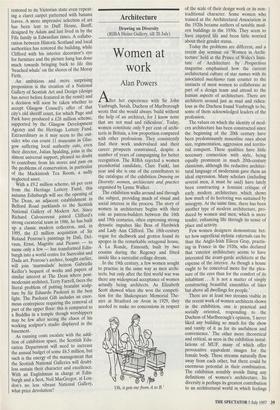Architecture
Drawing on Diversity (RIBA Heinz Gallery, till 20 July)
Women at work
Alan Powers
After her experience with Sir John Vanbrugh, Sarah, Duchess of Marlborough wrote that she would always 'build without the help of an architect, for I know none that are not mad and ridiculous'. Today, women constitute only 9 per cent of archi- tects in Britain, a low proportion compared with other professions. They consistently find their work undervalued and their career prospects constrained, despite a number of years of campaigning for better recognition. The RIBA rejected a women presidential candidate, Clare Fankl, last year and she is one of the contributors to the catalogue of the exhibition Drawing on Diversity: women, architecture and practice organised by Lynne Walker.
The exhibition walks around and through the subject, providing much of visual and social interest in the process. The story of women in architecture begins with their role as patron-builders between the 16th and 19th centuries, often expressing strong dynastic impulses like Bess of Hardwick and Lady Ann Clifford. The 18th-century vogue for shellwork and grottos found its apogee in the remarkable octagonal house, A La Ronde, Exmouth, built by two cousins during the Regency and fitted inside like a surrealist collage dream.
In the 19th century, a few women sought to practise in the same way as men archi- tects, but only after the first world war was there any widespread acceptance of women actually being architects. As Elizabeth Scott showed when she won the competi- tion for the Shakespeare Memorial The- atre at Stratford on Avon in 1929, they needed to make no concessions in respect 'Oh, it gets me from A to B.' of the scale of their design work or its non- traditional character. Some women who trained at the Architectural Association in the 1920s became authors of notable mod- ern buildings in the 1930s. They seem to have enjoyed life and been little worried about their gender status.
Today the problems are different, and a recent day seminar on 'Women in Archi- tecture' held at the Prince of Wales's Insti- tute of Architecture by Perspectives magazine emphasised how the current architectural culture of star names with its associated machismo runs counter to the instincts of most women to collaborate as part of a design team and attend to the human aspects of architecture. There are architects around just as mad and ridicu- lous as the Duchess found Vanbrugh to be, some of them acknowledged leaders of the profession.
The values on which the identity of mod- ern architecture has been constructed since the beginning of the 20th century have been predominantly masculine ones about size, regimentation, aggression and territo- rial conquest. These qualities have little necessary connection with style, being equally prominent in much 20th-century classicism, although the reductive architec- tural language of modernism gave them an ideal expression. Many scholars (including several men, it must be said) have lately been constructing a feminist critique of early modern architecture which shows how much of its hectoring was sustained by misogyny. At the same time, there has been another type of modern architecture, pro- duced by women and men, which is more tender, enhancing life through its sense of place and activity.
Few women designers demonstrate bet- ter how superficial stylistic externals can be than the Anglo-Irish Eileen Gray, practis- ing in France in the 1920s, who declared that 'exterior architecture seems to have interested the avant-garde architects at the expense of the interior. As though a house ought to be conceived more for the plea- sure of the eyes than for the comfort of its inhabitant .. . It is not a matter of simply constructing beautiful ensembles of lines but above all dwellings for people.'
There are at least two streams visible in the recent work of women architects shown in the exhibition, one is practical and socially oriented, responding to the Duchess of Marlborough's opinion, 'I never liked any building so much for the show and vanity of it as for its usefulness and convenience.' The other more theoretical and critical, as seen in the exhibition instal- lations of MUF, many of which offer provocative equivalent images for the female body. These streams naturally flow away from each other, but there could be enormous potential in their combination. The exhibition sensibly avoids fixing any definitions of women's architecture. Its diversity is perhaps its greatest contribution to an architectural world in which feelings are endlessly dismembered and cate- gorised.
The idea that architecture could offer pleasures beyond the formal and visual comes to mind in the Portable Architecture exhibition at the RIBA headquarters, 66 Portland Place (until 5 July). This uses lots of sound and flashing light to promote the idea that buildings (or things resembling them) can be trolleyed, trucked, or airlifted from place to place. It has been immensely popular as an exhibition, showing, no doubt, how the public finds normal archi- tecture boring, but evades the issue of place that is essential, even to the transito- ry. The charming version of a nomadic yurt, the first exhibit, would make one feel immediately at home wherever it was set down. It is soft and warm, patterned and colourful and its central opening, like the oculus in the dome, is, as Ananda Coomaraswamy explained, 'the door by which one breaks out of the universe'.
Modern architects feared textiles as rep- resentations of the feminine, but they are one means of going beyond the optic limits which Eileen Gray condemned, offering a range of visual and non-visual sensations, modifying the sound quality, temperature and humidity of the environment and con- necting it to the body. The raucous colours and shiny textures displayed in Portable Architecture deny the possibility of these simple pleasures.



























































 Previous page
Previous page